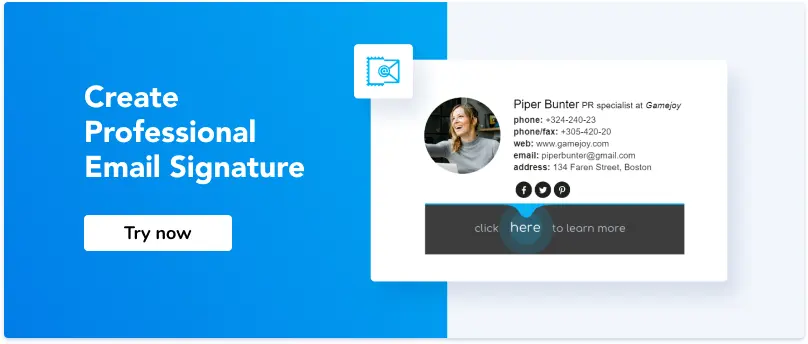How to Write an Email to a Client after the Meeting
1.How to write a follow-up message to clients and use it as a part of your networking
2. When to send a follow-up email?
3. How to choose a proper subject line?
4. How to structure follow-ups
5. Key fails when sending after meeting emails
6. Follow-up email templates
If you are a B2B business, you depend on regular meetings with clients. It doesn’t matter if these are phone calls or actual face-to-face encounters, the point is that you’ve made a connection. However, it is usually not enough. You need to stay in touch with your clients, to make them remember you, your company, and your services. In our experience, the best starting point here is writing a follow-up thank-you email after the meeting.
Like meeting invitation or cancellation emails, follow-up messages are something that you should master to be better in business communication. Unfortunately, not everybody is aware of the power of follow-ups. What’s more, not everybody is good at following up. This is why we are dedicating the current article to issues, including:
Useful tools:
1. Newoldstamp - Email signature marketing
2. Mailchimp - Email builder and sender
3. Pabbly Connect - Automate all your integrations & tasks
4. RocketLink - Your branded short linker
5. Canva - Online tool for making designs
Apart from the basics, we’ll also cover some typical mistakes people make when following up after a business meeting.
Your follow-up thank-you email after a meeting is a part of networking
A thank-you email after a meeting is not just a nice touch, but a necessary step in building and maintaining any business relationship. Sending a personalized thank-you note for the business meeting establishes a connection with your clients.
The power of a thank-you letter after a meeting:
- It reminds your client of a recent meeting with you
- It sets the tone of your communication with the client in the future
- It ensures that you and your client are on the same page after the meeting
- It lets you provide a recap of the planned activities
- It speeds upbringing your mutual plan to life
Send a meeting follow-up email ASAP
The first rule of follow-up: send yours as soon as possible. And better do it on the same day, while the memory is fresh, and the mind’s not been changed. Failing to write the client within the first 24 hours after your meeting might result in losing the progress you’ve made with them.
Imagine a situation: your client has several appointments with different companies in one day. The same problem is discussed. Within the next few days, some companies follow up, and some don’t. Although the solutions that you and your competitors propose might be different, the client is more likely to remember and choose those who wrote a follow-up email. So, act quickly. Send your message ASAP.
Choose a proper “follow-up email after the meeting” subject line
You’ve made up your mind to send a follow-up message shortly after the appointment: great! Now here’s your first challenge: to write a subject line for a thank-you email after the meeting. A quick tip: by your email subject, the addressee should immediately know what the letter is about.
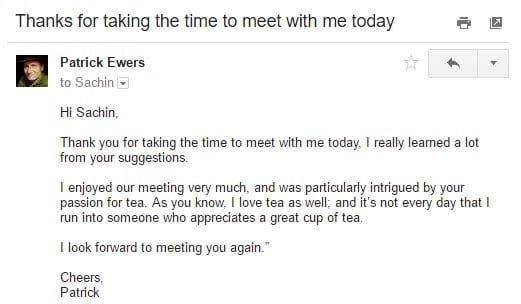
Avoid too general subjects like “Thank you” or “A quick follow up” and try to be slightly more specific. What are you thankful for? What are you following up on? Such as:
A quick follow-up on today’s meeting
Your subject line for a follow-up email after the meeting might contain the name of the person or people with whom you met. This will make your message more personal. Like in the examples below:
Great meeting you today, {Name}
It’s been a pleasure meeting you, {Name}
If you want to get straight to business, your follow-up email subject line after the meeting should be a little more official and to the point. You can try one of those:
Today’s meeting takeaways
Our yesterday’s meeting follow-up
Here are a few recommendations on {insert the discussed topic here}
Structure of a follow-up email after a business meeting
Now, what should be inside your after-meeting email? For sure, it must start with a greeting and be followed by a thank you. It is recommended to mention the topic discusses at the meeting and the main takeaways. Then, you will need to suggest further plans or steps and provide a clear call to action. Always end with closure and your business email signature.
To recap, the structure of a meeting follow-up email looks as follows:
- Greeting
- A thank you
- Statement of the discussed topic(s)
- Main takeaways
- Next steps
- A call to action
- Closure
- Your email signature
Below we’ll take a look at writing a business meeting follow-up email in more detail. Meanwhile, it’s worth saying that it’s essential to adhere to specific rules when sending a follow-up meeting email. Adding common-ground references or suggesting the next meeting would make your follow-up email after a business meeting more personal and to-the-point. Read on to learn about some good practices for writing follow-ups.
1. Say "thank you” for the meeting
As mentioned earlier, it’s crucial to start your email with a thank you. However, be specific. What are you thanking for? You may be grateful for the client’s time, for insightful inputs, for sharing useful information about their company with you, or for the meeting itself. Be appreciative.
2. Add a common-ground reference
Write about the shared aspects that you’ve learned about during your meeting. Emphasize some positive elements of the appointment, such as a shared interest in coffee, a place you both went to school in, or a recent conference that you both attended. Write only what’s appropriate and don’t act overly familiar with the person.
3. Add a meeting recap in your email
Sometimes, your follow-up serves as a meeting recap email or a meeting summary email. There are the messages in which you summarize your meeting chronologically or logically. List your primary takeaways by answering the following questions:

4. Follow up on the promises you made at the meeting
After the meeting, you will most certainly have some homework to do. If you drafted a plan, provide the client with an approximate timeline of its execution. If you promised to answer a question or look up the best option to tackle the client’s problem, send the respective information to him or her in your follow-up.
5. Request the documents you agreed on
In case you agreed on working together, make sure you have the necessary documents before you start the work. An email after the business meeting is the best occasion to ask for the papers. Make sure you send the required documentation on your part as well.
6. Note the next date of contact
You will probably need to have another appointment with this client. It might be to update them on your progress or to discuss the further steps. Make sure you take the initiative regarding the next meeting, and it’s better to do in advance. Suggest a date for your next get-together and make certain that you both add it to the calendar.
7. Add closing line
The email closure matters as well. Be professional and avoid informal closings, such as “See you later” or “Take care.” Stay formal and end your follow-up email with a classic “Best regards” followed by your business email signature.
8. Use a professional email message closing
The fundamental aim of following up is to have additional iteration with your prospect. You want the client to contact you back more than ever. Make yourself reachable. You might have exchanged business cards on the meeting, but it can get lost in piles of papers on the desktop or fell out of the pocket. The easiest way is to add a functional and interactive email signature. It will not only make your email look more professional but also provide your prospect with extra contact detail. Use an html email signature generator like Newoldstamp fo this. So if they feel comfortable with giving you a call rather than writing you a message, let them use the number from your signature.
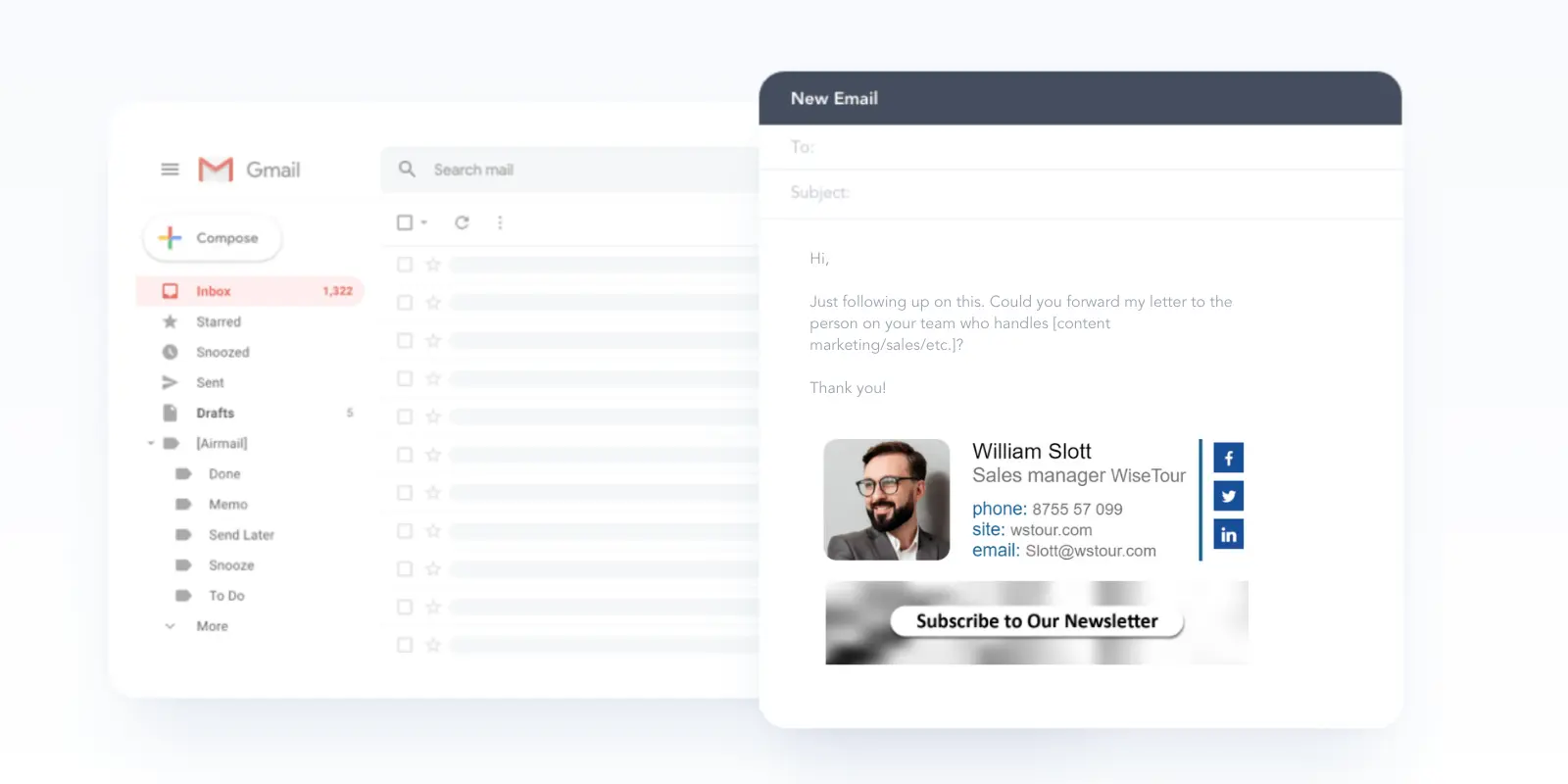
You can go even further. Make your signature speak to the prospect. All you have to do is add the banner with the right message and link it to the relevant landing page or case study. You can see the good examples here.
Key fails when sending after meeting email
1) Sending your meeting follow-up to a wrong person
Probably the biggest mistake you can make is sending your after-meeting email to the wrong person. It will not only be odd, but you might also reveal sensitive information to a third party. So be careful with your To field. To be safe, you can find a thread with your client and respond to it with a new subject. If you’ve had a meeting with more than one person, make sure to include them all in your follow-up.
2) Making your thank-you email too long and not keeping it to the point
You don’t need to write a detailed transcript of your meeting. Just a thank you, a quick recap of the essential points, and a clear statement of the following steps with a call to action. That would suffice.
3) Not double-checking grammar
You should always pay extra attention to your grammar when communicating with clients. Spelling mistakes do sometimes cost lives. Jokes aside, they still can cost you important deals. Make sure your writing is impeccable by enabling tools like Grammarly. Also, do not rely on auto-correction.
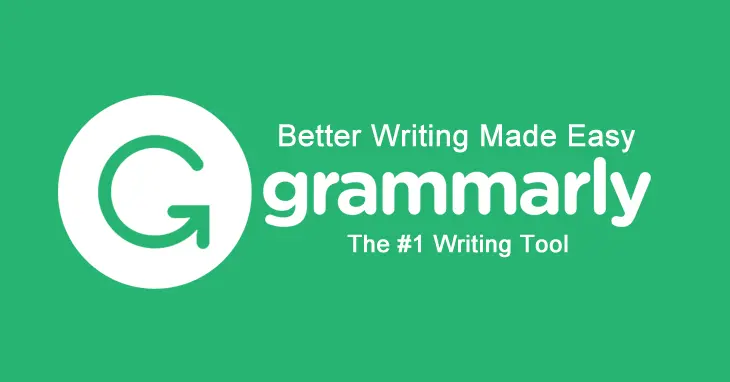
4) Not including your additional contact information
Surely, your client must have your contact information already. But bad things happen, contacts can be lost, so you have to always include your phone number in your email signature. In case he or she has a pressing matter that needs to be discussed over the phone, they will always find that number in your latest email.
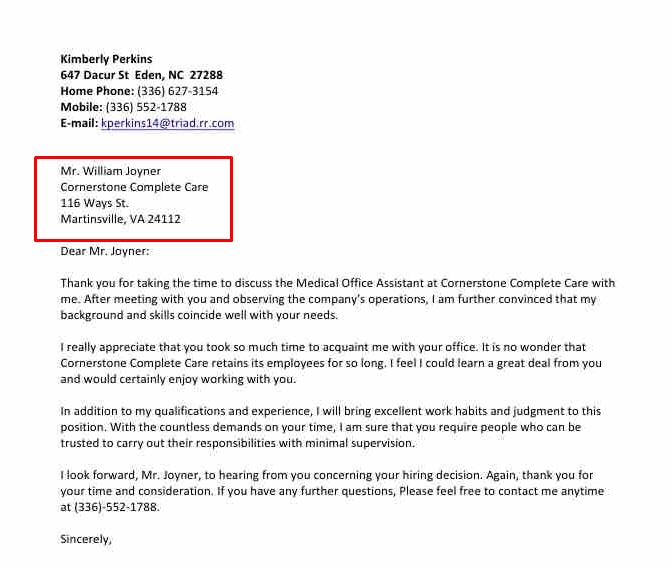
Image courtesy of Acknowledgeform
5) Waiting too long to send your thank-you email after the business meeting
Try to send the follow-up no later than 24 hours after the meeting. By waiting too long, you might risk losing your client to competitors (the worst-case scenario). Even if you are sure that your relationship with the client is safe, you might just forget some essential takeaways from the meeting.
6) Writing a generic thank-you note
Don’t write a generic thank you. Always be specific and personal and do not send all your clients the same email. Even though you might use templates, customize every single piece of correspondence. It will take some time to craft a follow-up email, but it will bring results in the end.
7) Showing your custom fields
In case you are using email templates, make sure your custom fields or merge tags are all replaced by actual information about the client, or else you can use an email template builder for creating customizable designs. Leaving chunks of symbols like {!FirstName} is unacceptable: your follow-up will look like an impersonal bulk message. In case you are using an email-sending platform, don’t send anything without testing it first.
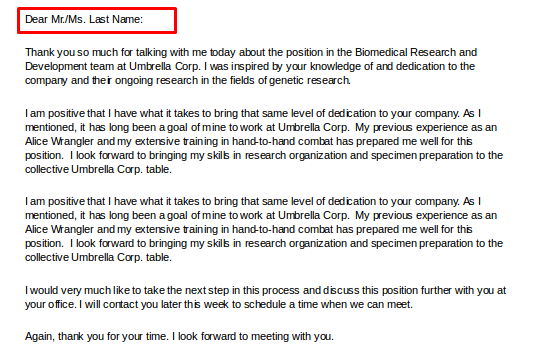
Customizable follow-up email templates after a meeting
Enough about the DOs and DON’Ts. Let us better give you a real follow-up meeting email sample. This is just an example of what you can write in your messages and how you can write them. You can take them and use them. Just be sure to replace our sample information with what’s relevant to you.
Here is a sample thank-you letter after meeting a prospective client: Dear Henry,
Dear Henry,
Thank you for taking the time to meet with my colleagues from SailOnEmail and me today regarding your email marketing goals. It’s been a pleasure talking to you and learning about YourCompany.
Let me outline the main takeaways from our meeting:
- Your team will enjoy a 3-month trial of our platform
- We will help you set up your account and will be available to answer any of your questions
- We are meeting in 2 months again to discuss your experience with the platform and to find how you can use it to even more advantage
I will write you next week to arrange our next meeting with you and your team. Meanwhile, if you have any questions, please feel free to message or call me.
Looking forward to hearing from you.
Kind regards,
 Below is a slightly more detailed sample follow-up email after meeting a potential client:
Below is a slightly more detailed sample follow-up email after meeting a potential client:
Dear Henry,
Thank you for taking the time to meet with me and my colleagues from SailOnEmail today regarding your email marketing goals. It’s been a pleasure talking to you and learning about YourCompany.
Here are the main takeaways from our meeting:
- We have agreed on a 3-month trial of our Pro platform for your team.
- My colleague Peter will guide Jeff of your Marketing Department through the account setup process.
- I am sharing with you our 2023 report on the best practices for a welcome email series.
- My colleagues or I will be available to answer any questions that you might have in the process.
- We agreed to meet in a few months to discuss your experience with the platform and to work on the ways for you to exceed your 2023 marketing targets.
You mentioned that you would like to have a bigger following on Facebook. What do you think about remarketing campaigns? Targeting your existing email subscribers on Facebook could help you grow a dedicated audience. If you are interested, I can tell you about this in more detail.
Meanwhile, please see the report on the welcome email series attached.
Peter will be contacting Jeff tomorrow at 12 PM. He will have everything ready for the setup by then.
If you would like to try remarketing, we can arrange a quick call tomorrow between 3 PM and 5 PM or Friday between 12 PM and 3 PM. What do you think?
Looking forward to hearing from you.
Kind regards,
 To sum it all up, always message your clients after a meeting, regardless of how long you’ve been working with them. Remember that, when writing a follow-up email after the meeting, the subject line, thank you, meeting recap, and a call to action are your key elements to have. Make sure you don’t make mistakes, from typos to sending the email to the wrong addressee. Keep your message concise, personal, and polite.
To sum it all up, always message your clients after a meeting, regardless of how long you’ve been working with them. Remember that, when writing a follow-up email after the meeting, the subject line, thank you, meeting recap, and a call to action are your key elements to have. Make sure you don’t make mistakes, from typos to sending the email to the wrong addressee. Keep your message concise, personal, and polite.


